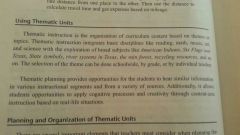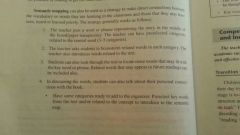![]()
![]()
![]()
Use LEFT and RIGHT arrow keys to navigate between flashcards;
Use UP and DOWN arrow keys to flip the card;
H to show hint;
A reads text to speech;
48 Cards in this Set
- Front
- Back
- 3rd side (hint)
|
Thematic |
Organizing curriculum content based on a theme or topic |

|
|
|
Semantic mapping |
Technique used to assess comprehension Visual representation of interconnected characteristics or features of a given concept |

|
|
|
Semantics |
How meaning is conveyed through vocabulary |
|
|
|
phonological Awareness |
awareness and ability to manipulate the sounds of spoken words |
|
|
|
Alphabetic Principle |
understanding that letters represent sounds effective instruction: teacher directed, manipulation of letters to change words |
|
|
|
onset/rime |
onset: initial consonant's sound Rime: remaining syllable sound eg. S(onset) at(rime)= sat |
|
|
|
sequence for introducing Phonemes |
1)comparison-beginning, middle, end 2) blending 3) linking letters to sounds 4)manipulating phonemes- deleting, substituting, adding letters |
|
|
|
stretch out vs. sound out |
children should begin by stretching words rather that sounding each letter- eg. ssssaaaattt vs. s--a--t |
|
|
|
best predictors of future reading success |
phonemic awareness and alphabetic knowledge |
|
|
|
Direct reading thinking activity (DRTA) |
guided reading activity- teacher breaks text into shorter segments, facilitates discussion, predictions |
|
|
|
phonemic awareness |
ability to work with individual sounds- focuses on sounds not meanings
|
|
|
|
beginning readers |
read 90% of words in a story easily and after practice should be able to do so fluently |
|
|
|
balanced reading program |
five main areas: phonemic awareness, phonics, fluency, vocabulary, and text comprehension. |
|
|
|
morpheme |
smallest unit of meaning |
|
|
|
open word sorts |
students explore how to categorize a set of words |
|
|
|
closed word sorts |
the teacher tells the students the criteria for sorting a set of words eg. sorting based on tense |
|
|
|
consonant diagraph |
two consonants that make one sound eg. ph=f, or th |
|
|
|
consonant blend |
blending of two consonants where each letter is still heard eg. b and l in the word "blend" |
|
|
|
vowel diagraph |
two vowels that make one sound eg. ee in week or oa in boat |
|
|
|
dipthong |
vowel pair that blends one vowel sound with another eg. oi in foil and oy in toy, also ou in out and ow in cow |
|
|
|
cloze procedure |
assessment method use to determine readability of a text. words are deleted and the learner uses clues from surrounding text to fill in the blank |
|
|
|
structural analysis |
word identification skill that focuses on word parts like prefixes and suffixes |
|
|
|
semantic analysis |
using word order and knowledge of language patterns to identify words and word meanings |
|
|
|
reading fluency |
rate and accuracy |
|
|
|
spelling development stages |
1)prephonemic- begins experimenting with sounds and letters but no match between letters and sounds in words 2)phonemic- sound way through words, eg. tak= take 3)transitional- shows understanding that do not need one-to-one matching with sounds and letters 4) conventional uses correct spelling |
|
|
|
frustrational reading level |
less than 90% of words read correctly |
|
|
|
instructional reading level |
90%-95% of text this provides the learner with the opportunity to practice sounding out and decoding text |
|
|
|
independent reading level |
reads and understands 95%-100% of the text
|
|
|
|
steps in writing process |
1)prewriting- graphic organizers, determining purpose and audience 2) develop draft 3) revise for coherence 4) edit 5) use available tech to finalize and publish
|
|
|
|
expressive and receptive language skills |
expressive: speaking and writing receptive: listening and reading |
|
|
|
KWL Chart |
graphic organizer- three columns 1) what I know 2) what I want to know 3) what I learned |
|
|
|
ballad |
narrative poem that tells a story |
|
|
|
sonnet |
14 lines with a rhyming scheme |
|
|
|
lyric poem |
rhythmic and melodic, easy to memorize- usually personal or descriptive
|
|
|
|
Acostic poem |
first letter of each line spells a word (usually the title of the poem) |
|
|
|
Diamante |
seven lined poem in a diamond shape |
|
|
|
quantrain |
poem consisting of four lines of verse |
|
|
|
cinquain |
short, un-rhymed poem consisting of 22 syllables (2,4,6,8,2) in five lines |
|
|
|
limerick |
rhymed, humorous, nonsense poem of five lines with the last line ending with a surprise twist (AABBA) |
|
|
|
Haiku |
unrhymed Japanese, three lines 5,7,5 syllables
|
|
|
|
expository writing |
writing used to explain, describe, and/or give information |
|
|
|
alliteration |
repeated consonant sounds at the beginning of the words eg. big, blue bear bounded the brown ball. |
|
|
|
onomatopoeia |
words that mimic sounds eg. pop, bang |
|
|
|
Sustained silent reading ssr |
15-30 minutes of silent independent reading time not to be used in place of instructional reading |
|
|
|
syntactic clues |
word's placement in a sentence to determine meaning of the word |
|
|
|
how long should phonics be taught? |
The National Reading Panel has determined that two years is sufficient. If phonics is taught at the beginning of first grade than it should be taught till the end of second grade. |
|
|
|
Graphophonemic Knowledge |
Letter recognition and letter-sound correspondence |
|
|
|
free verse |
poetry that lacks rhyme and meter. good choice for a student that wants to write a poem but doesn't know much about poetry |
|

